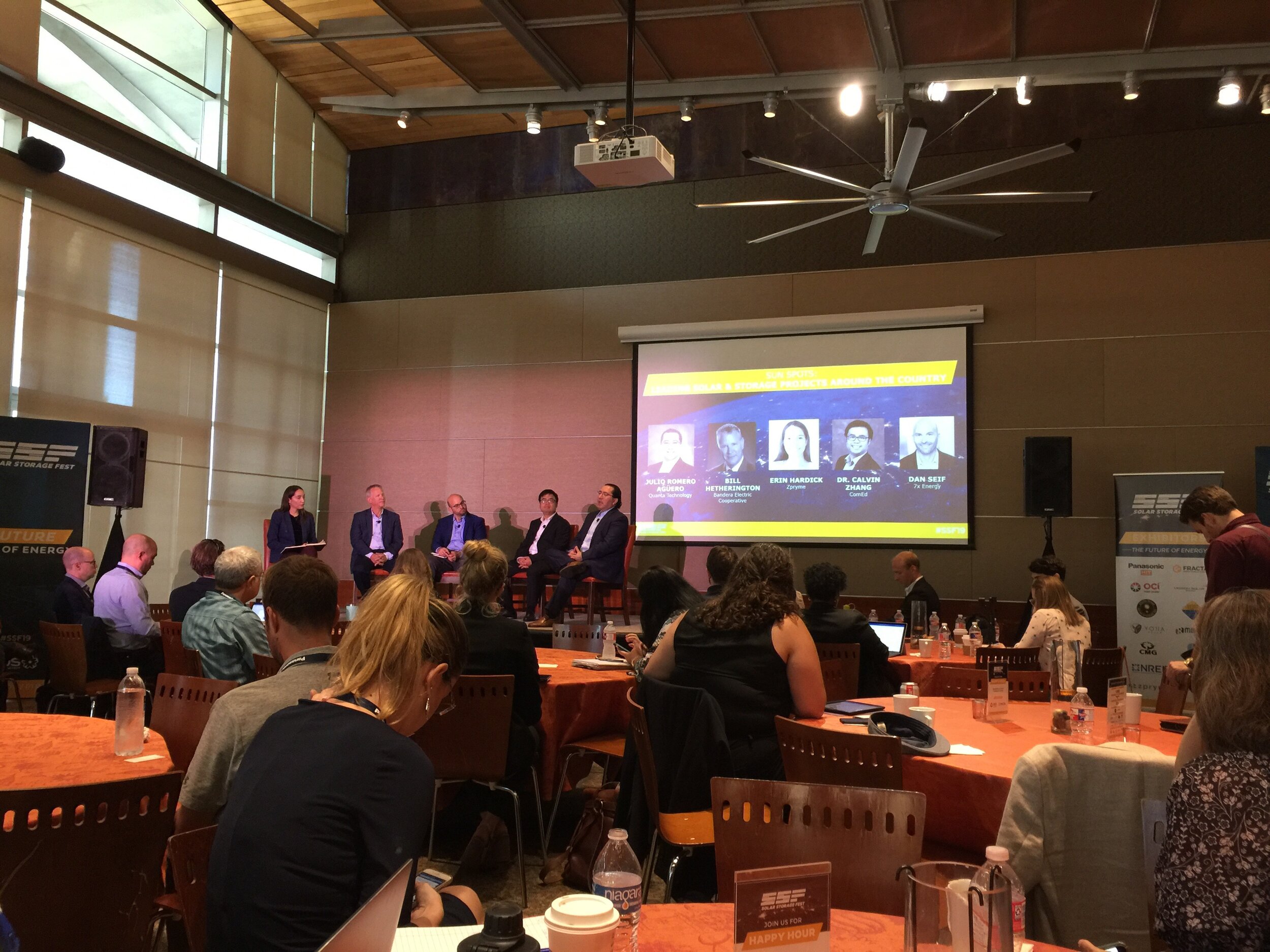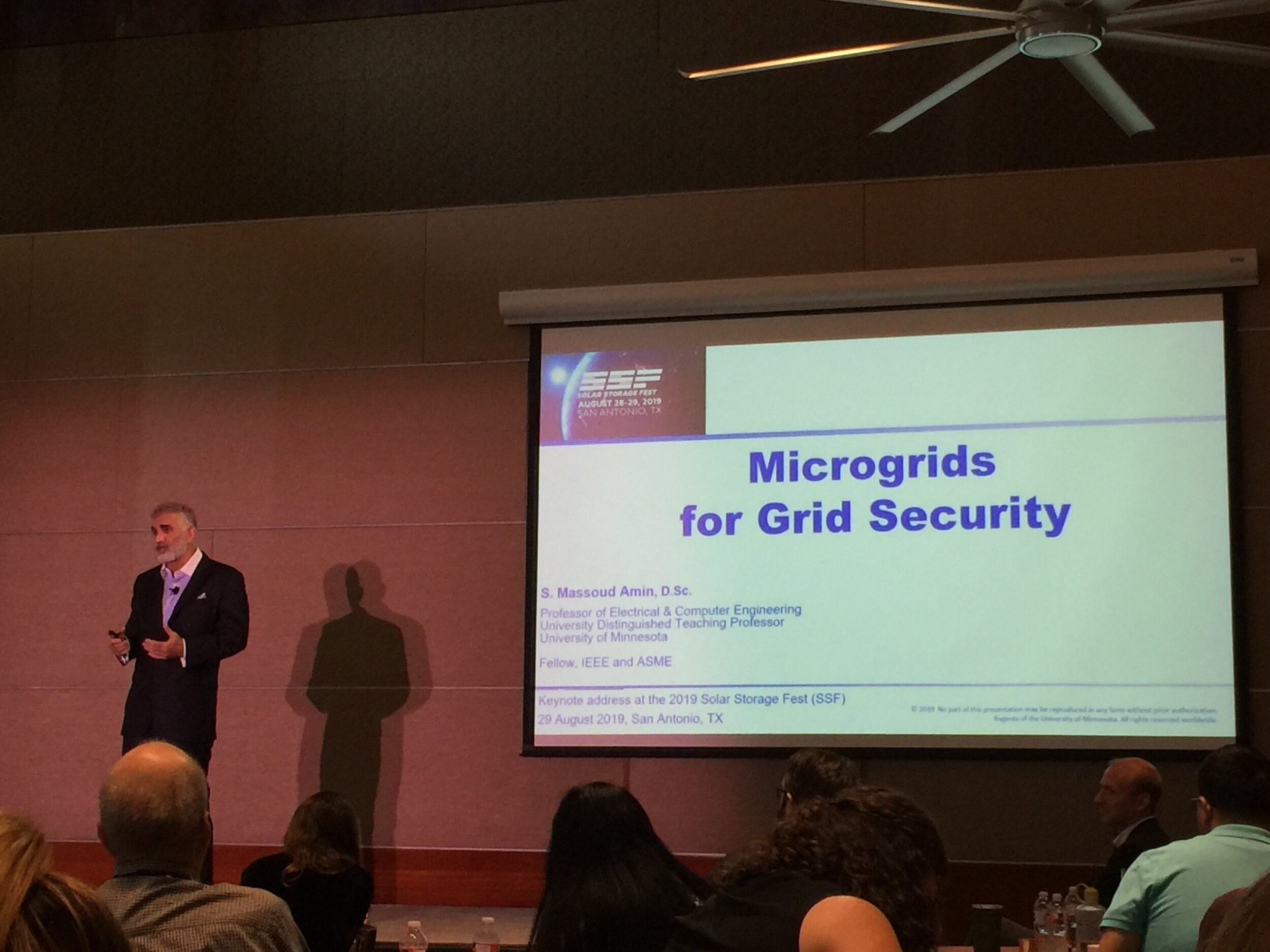Solar Reliable Source of Energy
The last couple of weeks have been quite productive and promising for the Texas solar industry. The 2019 Solar and Storage Festival (SSF19) was organized by Zpryme in San Antonio to bring experts together to explore market growth opportunities, innovative financing, and how to position solar and battery storage at the center of the energy transition. SSF19 offered opportunities for utilities, industries, and community leaders to participate and share their ideas and concerns, with a focus particularly on the effects of extreme weather on the supply and demand of electricity.
As a person who has advocated fighting for climate change and implementing climate solutions to reduce our vulnerability to the impacts, I am particularly interested in the emerging field of solar energy and battery storage as a part of the climate solution. I found my new employer, Lighthouse Solar, to be a dedicated local company committed to transitioning Texas to clean, affordable, distributed, renewable power sources.
I studied Energy Policy and Administration at Texas Tech University where I was fortunate to have worked on several projects related to climate crisis and energy efficiency. So, I was interested in taking part in SSF19 to explore more about the future of the solar and storage market in Texas. Prior to this opportunity, I participated in Dr. Katharine Hayhoe's classes, panel discussions, and presentations which were instrumental in opening my eyes to the necessity of being prepared for the negative impacts of climate change and reducing communities' vulnerability against climate change. The climate is rapidly changing; reducing carbon emissions, particularly from the energy sector, and shifting our reliance away from fossil fuels toward renewable energy is one of the most important ways to mitigate impacts.
Extreme weather events such as hurricanes and storms across the United States are becoming more frequent and the damage done is exacerbated due to climate change. Communities are affected on a broader scale each year. As the weather gets warmer, hurricanes are exemplifying:
● increased intensity
● increased wind speeds
● more frequent occurrences
● higher levels of precipitation associated with them
● a lead to increased sea-level rise, which further increases storm surge
We have seen all of these characterizations in the past few hurricane seasons. One of the negative impacts of extreme weather are the long-lasting power outages which increasingly threaten vital infrastructures such as hospitals, police stations, and fire departments. The significant role of solar energy, battery storage, and microgrids to maintain a reliable source of energy to the public during these events is undeniable. At the national security level, solar energy and battery storage are paramount to preparing for the magnitude of future impacts.
Why it Matters?
Impacts to the Economy and Security
The reliability, security, and resilience of the energy system are interconnected with every sector of the U.S. economy and frequent outages would have a critical impact on our economy and national security. At SSF19, industries and utilities came together to explore solutions and opportunities to position solar and battery storage at the center of the energy transition to respond to the impacts of catastrophic events. To meet this goal, smart grid and microgrid technology are presented as a key tool in the integration of storage and renewable energy as well as improving communities’ resiliency.
SSF19 provided a thought-provoking dialogue with some of the most influential and forward-thinking individuals and organizations, centered around solar and energy storage solutions. For example, the Sweatt Chair in Technological Leadership and the Director of the Technological Leadership Institute at the University of Minnesota, Dr. Massoud Amin, discussed how solar storage and microgrids can help create a more resilient energy system. His research has shown that the cost of generating electricity by renewable energy is remarkably cheaper than fossil fuels. The Return on Investment (ROI) related to the project, which utilizes renewable energy to generate electricity, was anticipated to be about a year and a half, Read More.
Dr. Amin argues that domestic policy and customers' engagement are the primary drivers for nations to become fossil-fuel-free. He states:
● “Customers engagement is critical to successful policy implementation to enable end-to-end system modernization”
● If the transformation to a smart grid is to produce real strategic value for our nation and all its citizens, our goals must include: “Enable every building and every node to become an efficient and smart energy node”
In my opinion, the most impactful section of SSF19 was energy security and the necessity of implementing smart grids and storage to ensure eliminating long blackouts and providing reliable sources of energy to the nation. The clearest message delivered at SSF19 was the fact that solar photovoltaics (PV) is playing a key role in the energy system transition. Associated costs have fallen substantially so that solar is now competitive with fossil fuel-fired generation in many parts of the world. Many utilities in the U.S. are investing in solar to generate electricity and they have integrated solar with battery storage and smart grids to handle blackouts and peak demands. For example, the Electric Reliability Council of Texas (ERCOT) CEO, Bill Magness, discussed the impact of implementing renewable energy and battery storage on the Texas grid in this era of rapid innovation in the electric sector. He states triple-digit temperatures across Texas are putting a strain on the state's electric grid system. ERCOT manages the flow of electricity for about 90% of the state's customers and can generate a maximum capacity of about 78,000 megawatts of electricity for peak demand, according to ERCOT. However, in Texas, the strain on the grid was so volatile this summer that wholesale electricity prices spiked to $9,000 a megawatt-hour. Thus, he provided an overview of what elements have been driving solar and storage in the ERCOT market over the last few years.
Challenges Identified at the Conference?
Several challenges prevent widespread implementation of solar and battery storage in the U.S. The most important one is the lack of policies that favor large deployments of renewable energy and lack of government subsidies to motivate utilities and companies to invest in the renewable energy industry. Despite nations worldwide committing to a reduction in carbon emissions and implementing renewable energy through the Paris Agreement, the fossil fuel industry continues to receive huge amounts of taxpayer funding. However, while the renewable energy price drops significantly, many experts were wondering why subsidies for the fossil fuels industry have increased. In addition, domestic policies are largely responsible for the support of renewable energy. For example, the 30 percent Solar Tax credit (ITC) is due to drop by four percent in 2020. As the solar industry’s tax break is stepping down and the value of the subsidy will fall for three years until it ends for residential solar and permanently drops to ten percent for commercial solar, a lack of favorable long-lasting policies can be identified as one of the biggest challenges for the solar industry. If we want to encourage people to invest in renewable energy, we need long-term stable policies to encourage the public to participate in the carbon reduction plan.
Why It Matters to Customers?
Understanding the increased risks posed by climate change will help people plan for, respond to, and recover from destructive and dangerous weather. Extreme weather and sudden changes to the climate condition are happening now, particularly to those who live in Texas. We have experienced the hottest July on record for our planet and Texas residents have received several energy conservation alerts in the last few months.
Recently, we have seen dramatic increases in demand for installing a solar panel system and battery storage. Since last year, Lighthouse Solar has installed more than 150 Tesla Powerwalls. The battery storage industry is expanding and the need for having backup power during the outage is a necessary part of the sustainable community.
You might wonder why people are so interested in battery storage, lately? They are looking for a secure and stable way to ensure that they will have access to the energy during the heatwave and storms as well as handling blackouts and power outage. At Lighthouse Solar, we are communicating with customers on a daily basis and our customers are very interested in generating their own electricity and to contribute to the carbon-free community. Rooftop solar PV has been a very interesting investment for homeowners and businesses as Austin Energy provided $35,00 incentives to enlarge base savings on the solar power system installation. The need for having backup power during an outage is a necessity for those who are in critical and serious conditions such as geriatric people. On the other hand, as storm-related power outages are getting more frequent, utilities’ old-fashioned distribution system is not capable of responding to catastrophic events and as a result, they have no choice except to shut off the customers’ power to maintain the reliability and safety of their systems. Thus, people have realized the great advantage of generating their own electricity and using battery storage to have backup power during blackouts. Frequent changes in weather, storms, and hurricanes have brought about so many uncertainties to our lives and everyone would prefer to be prepared for any sudden changes.
We are living in a very complex and dynamic environment now. Every aspect of our lives depends on digital technology and so what would happen if we do not have access to electricity even for a few hours?
As communities rely on energy to perform, we need to invest in transitioning our reliance toward a more secure, stable, and affordable source of energy.
Conclusion
Overall, the main key points of the SSF19 can be summarized as follows:
● Solar energy is booming in the U.S. and in 2018, the solar industry generated a $17 billion investment in the American economy.
● Prices as of Q1 2019 are at their lowest levels in history across all market segments. An average-sized residential system has dropped from a pre-incentive price of $40,000 in 2010 to roughly $18,000 today. Recent utility-scale prices range from $28/MWh - $45/MWh, making it competitive with all other forms of generation.
The energy transition is accelerating, empowered by the low price of renewables. Utilities are investing in the solar industry as the ROI is becoming more substantial.
We are in a fascinating phase for the industry. Policymakers in many states are demanding a faster transition to a "clean" energy economy, but the pathway will be challenging. The SSF19 conference showed the importance of integration with energy storage and collaboration with a variety of stakeholders. In conclusion, to meet aggressive state and municipal goals for decarbonization, the pace at which solar and storage projects are deployed will need to increase dramatically. Whose job is it to help incentivize customer adoption? Utilities, solar and storage manufacturers, and the government. I am hopeful these discussions will continue in earnest at all levels to help place solar and storage in the center of the energy transition.








